Jade plants are easier to care for than most people think, even for beginners. They grow very well either indoors or outside, and can live for many, many years.
In this complete jade plant care guide, I will show you all you need to know for the best success. We’ll cover everything, from water, light, and soil, to pest control, fertilizer, troubleshooting common problems, and much more.
I have been growing jade plants, both indoors and outside, for a few decades. In fact, I still have the very first one I ever bought waaaay back in 2001, and it’s one of the oldest plants I own.
When I got it, it was a tiny thing in a 4″ pot, and now it’s about 3′ tall and wide (it’s the one in the photo above). Since then, I’ve added several others to my collection (you’ll see some of them in the pictures below). Every one of them is thriving, and I love them all.
Needless to say, I was very excited to write this guide to share my wealth of knowledge and expert hands-on experience with all of you.
Quick Jade Plant Care Overview
| Scientific name: | Crassula |
| Classification: | Succulent plant |
| Common names: | Jade plant, Money plant |
| Hardiness: | Zones 9-11 |
| Temperature: | 55-85°F |
| Flowers: | White or pink, blooms in winter |
| Light: | Full sun to partial shade |
| Water: | Allow soil to dry between waterings, do not overwater |
| Humidity: | Little to none |
| Fertilizer: | General purpose plant food in spring and summer |
| Soil: | Fast-draining, sandy soil |
| Common pests: | Mealybugs, scale, spider mites |
Information About Jade Plants
Jade plant (Crassula) is a perennial succulent that is native to parts of South Africa and Mozambique. In nature, they can reach heights of 6′ tall or more, and are often used as shrubs in warm climates.
They’re also known by the common name “money plant”. But don’t confuse it with other plants that go by the same common name, because they require very different care…
Different Types Of Jade Plants
There are lots of different types of jade plants, so you can grow a nice variety of them if you’d like to. I have several in my collection, and I adore every one of them. Here are a few of my favorites…
- Crassula ovata – This is the common jade plant variety that everyone knows and loves. It has rounded, flat leaves, and can grow to become a large shrub with a very thick trunk.
- ‘Gollum’ jade plant – Also called E.T. fingers or baby toes, this variety has really cool tubular shaped leaves that are long, narrow, and rounded.
- Crassula ovata ‘Hobbit’ – Often used interchangeably with the one above as they look very similar, this is commonly called “Shrek Ears” or “Ogre Ears” because the tubular leaves are wider on top as if they are tipped with suction cups.
- Dwarf jades – As the name suggests, dwarf varieties are simply a smaller version of the regular one. They look exactly the same, but have smaller leaves and will only grow to be a few feet tall.
- ‘Jitters’ – A unique variety that has thin, wavy, rippled leaves that are lighter green than the other types.
- Crassula arborescens – Also called a “Silver Dollar”, this gorgeous specimen has wide silver/gray leaves with red tips.
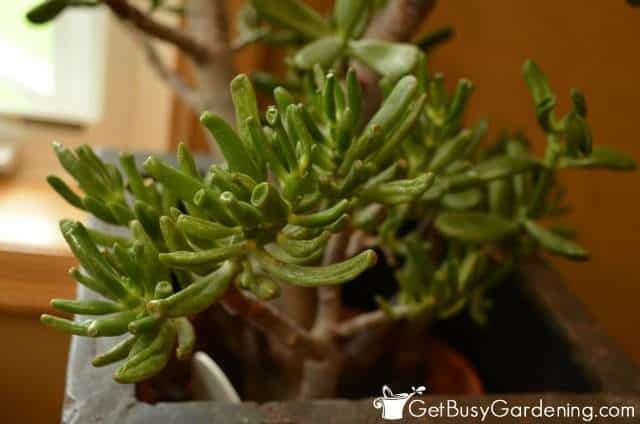
Flowers
Many people are surprised to learn that, with the proper care, jade plants can flower. In warmer climates where they grow outside year-round, they bloom during the winter. But it’s very uncommon indoors without help.
To get your jade plant to bloom, you need to give it similar conditions to what it experiences when it’s outdoors.
The trick is to give it tons of light during the summer. Then, expose it to cooler (but never freezing) temperatures in the fall, and allow the soil to dry out.
When you bring your jade back inside in the fall, put it in a sunny spot, and keep the soil dry. You should start seeing flower buds in a few weeks.
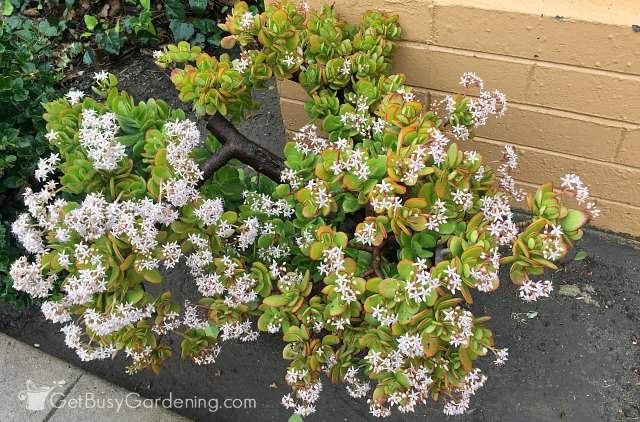
Crassula Toxicity
According to the ASPCA website, jade plants are toxic to dogs and cats if they ingest them.
My cats have never touched mine, but it’s a good idea to keep them out of reach if your pets like to snack on plants, just in case.
Where To Grow Jade Plants
If you live in a warm enough climate, you can grow your jade plant outside year-round. But they also do very well as indoor houseplants.
Hardiness
Jade plants are hardy down to zone 9. They can handle a bit of cold, and are even tolerant of light frost. But they will eventually die if it stays cold for too long.
If you live in an area with harsh winters, then you’ll either need to bring your plant indoors for the winter, or keep it as a houseplant.
Location
The best location to grow your jade plant is a sunny spot with dry soil. Outdoors, plant it in a spot where the ground is very sandy and fast-draining. Indoors grow your potted jade in a sunny, south-facing window.
You could keep it indoors year-round, or put it outside during the summer to give it a growing boost. Just make sure the pot has holes in the bottom, and bring it back inside before it drops below 60°F in the fall.
Related Post: Debugging and Cleaning Potted Plants Before Bringing Them Indoors
Jade Plant Care & Growing Instructions
For the most part, caring for jade plants is easy. But they do have some pretty specific growing requirements. So, for best success, follow my detailed instructions and tips below.
Watering
The biggest mistake that people make with jade plant care is overwatering, and this is their #1 cause of death. Too much will cause root and stem rot, quickly killing your plant.
You can learn exactly how to properly water your jade plant in this guide, but here are a few quick tips:
- Let the soil dry at least 2-3″ deep before giving your plant more.
- When it’s time, water deeply until it starts running out the bottom holes, and let it drain away completely.
- Give your plant less in the winter, and slightly more during the hot summer months.
- If you struggle with getting it right, get yourself an inexpensive soil moisture gauge to make it easy.
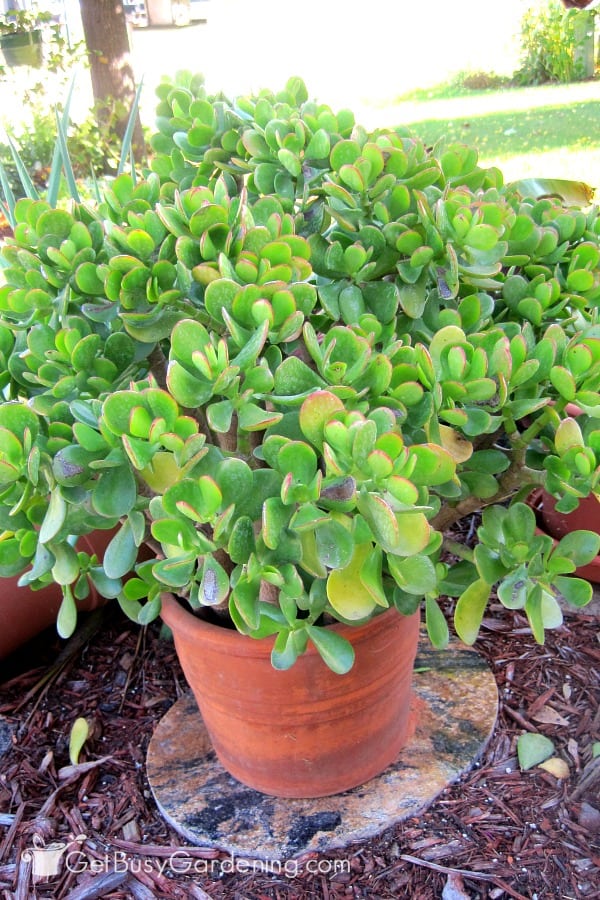
Light Requirements
Though they will tolerate partial shade, jade plants grow best in a full sun location. If it’s too dark, especially indoors, the stems and branches will become weak, thin, and leggy.
With enough sunlight, the stems and leaves will be thick and compact, and the trunk will turn brown and woody at the base. Also, the leaves or tips of your jade plant will turn red, making them even more beautiful.
Here’s are my tips to figure out the ideal amount light for your plant:
- Indoors – Place your plant in a sunny, south-facing window. If you don’t have enough natural sunlight in your house, then add a grow light to supplement.
- Outside – Grow your jade plant in a full sun to partial shade location. If it gets too much shade, then the leaves will stay green and your plant won’t flower.
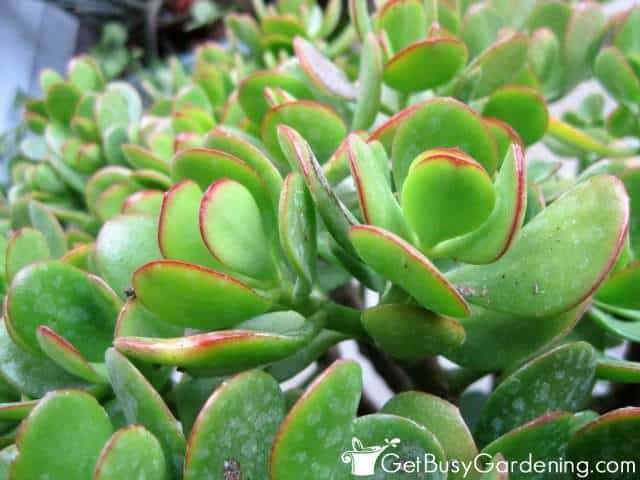
Temperature
Jade plants grow their best when the temps are between 55-85°F. They can handle occasional frost, but they’re not very cold hardy.
They’ll also survive brief periods of freezing temperatures, but will start to suffer if it’s cold for too long. So make sure to protect your plant or bring it indoors if it’s going to stay below 45°F outside.
On the flip side, they can handle the heat in the summer. But the leaves can start to shrivel in extremely hot and dry weather. So you should give your jade a little extra water during extended heatwaves.
Best Soil
Using the correct soil for your jade plant is a crucial part of their care. They need a porous and quick-draining mix. General purpose potting soils hold too much moisture, and can cause your plant to rot.
You can buy succulent soil, get a gritty commercial mix, or you can make your own by mixing coarse sand, potting soil, and perlite.
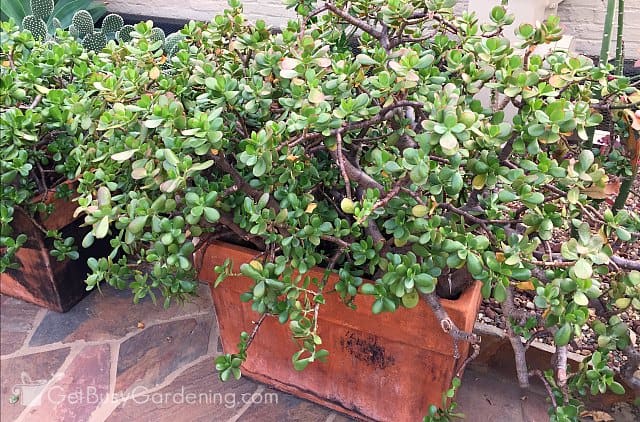
Repotting
Jade plants have very shallow roots, so they can live in the same pot for many years. In fact, it’s better to keep your plant a little root-bound, rather than repotting it too often.
When the time comes, choose a container that is 1-2 sizes larger than the current one. I recommend using an unglazed clay pot, but plastic or another type will work, as long as it has drainage holes in the bottom.
Fertilizer
You don’t need to worry too much about fertilizing as a part of your regular jade plant care routine. But it will help to encourage faster growth and flowers.
Apply a general purpose liquid monthly during spring and summer, or top-dress with slow-release granules once or twice.
Jades go into a dormant state during the colder months, and you should let them rest. So don’t fertilize during the fall and winter, or the new growth will probably be weak and leggy.

Pest Control Tips
Healthy jade plants don’t usually have problems with pests. But sometimes mealybugs, scale, or spider mites can attack them, especially indoors.
You can spot-treat small infestations by soaking a cotton swab in rubbing alcohol and using that to remove the bugs. For a larger or persistent outbreak, treat your plant with neem oil or a insecticidal soap.
Jades can be sensitive to some types of sprays though. So test any product that you want to use on a couple of leaves first to make sure there’s no damage before you treat the whole plant.
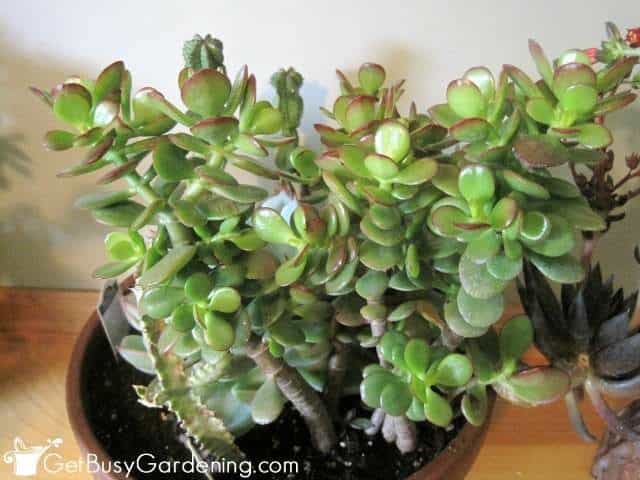
Pruning
Regular pruning is another important part of jade plant care. It will help to keep the foliage compact, and encourages the stems and the trunk to grow thicker.
Pinch off the new tips as they form in the spring or early summer, and use a sharp pair of precision pruners to trim leggy growth and encourage branching.
Get my full step by step instructions for when and how to your prune jade plant here.
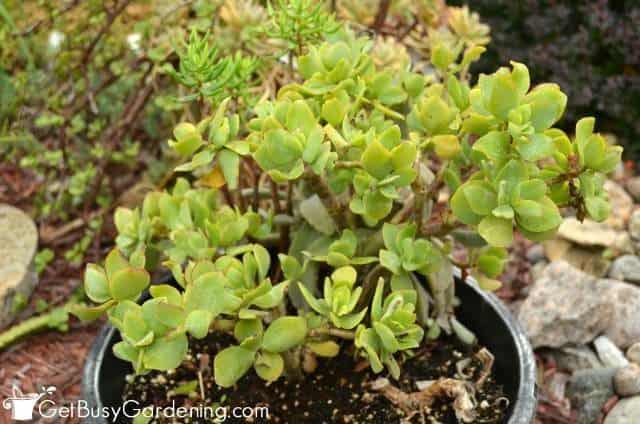
Propagation Tips
Jade plants are extremely easy to propagate, and you can grow tons of new babies by rooting either stem or leaf cuttings.
Allow the cut area to dry for a few days, then dip it in rooting hormone. Plant it in a slightly moist, well-drained soil mix, and in a few weeks it will form roots.
If you want to learn more about how to do it, then check out my detailed step-by-step jade plant propagation instructions here.
Troubleshooting Common Problems
In this section, I’ll help you troubleshoot some of the most common jade plant care problems you may have, with tips for how to fix them.
Leaves Or Branches Falling Off
When the leaves or branches start dropping off, it’s almost always caused by improper watering (usually too much), but it could be from a bug infestation.
Inspect your plant for signs of bugs, and treat any that you find. Ensure the soil dries completely before giving more, but never to the point where the leaves start shriveling or the plant droops. Use a moisture gauge to get it just right.
Mushy Or Rotting Stem Or Leaves
When the stem, branches, or leaves are brown and mushy, then it means they are rotting because of excessive moisture.
If they’re rotting on the top of your jade plant, then you can just prune off the affected parts. Otherwise, if the main stem is mushy, then you’ll have to take healthy cuttings to start new plants.
Leaves Turning Brown
This could be caused by improper watering or sunburn. If the brown leaves are soft and mushy, then they’re rotting from overwatering. Otherwise if they’re dried up and crispy, then your plant isn’t getting enough moisture
Ensure you’re giving your jade the correct amount of moisture, and harden it off before moving it into the full sun to prevent burning.
Trunk & Stems Turning Brown
It’s normal for the main trunk and branches to turn brown and become woody with age, and it means that you’re doing a great job of caring for your jade plant. However, if smaller stems suddenly turn brown after moving them into the direct sun, it is from sunburn.
In that case, move your jade back to the shade, and slowly acclimate it to the full sun over a period of a few weeks.
Shriveling Or Drooping Branches Or Leaves
When the leaves or branches shrivel, that usually means your jade plant isn’t getting enough moisture.
However, it can also be a sign that the stem has rotted. If the base is not mushy, then water your plant more often. Otherwise, treat it for rot.
Roots Growing On The Stem Or Branches
When roots grow on the stem or branches, they are called “aerial roots”. Though it’s not always a problem, this can be triggered by under watering, and also happens when the main stem is rotting.
Ensure your jade is getting enough moisture, and check the entire stem for signs of rot. If all is good, then you can just prune off the stems with aerial roots if they bother you, or leave them be.
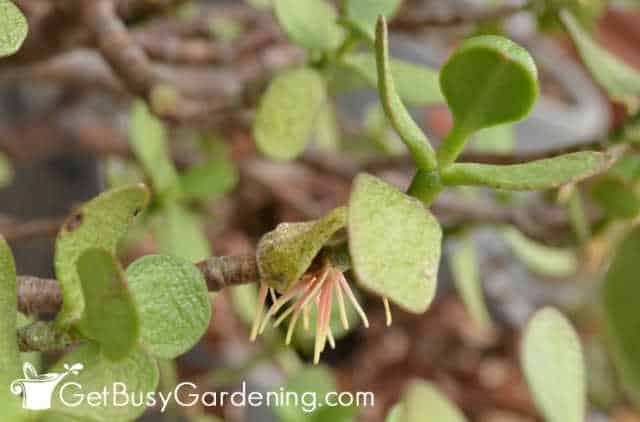
FAQs
Below I will answer some of the most frequently asked questions about growing jades. If you can’t find the answer to your question here, ask it in the comments below.
Is a jade plant indoor or outdoor?
You can grow jade plants either indoors or outdoors, depending on where you live. They aren’t cold hardy though, so you must move them indoors in freezing weather (anywhere less than zone 9).
Do jade plants go dormant?
Though jade plants don’t go fully dormant, they do go into a resting state in the cooler winter months. During this time, growth will slow, and they don’t require as much water.
Does a jade plant like to be root-bound?
Yes, jades like to be root-bound, and can live in the same pot for many years. Their root system isn’t very large, so keeping them in a smaller pot will help prevent overwatering.
Jade plants are easy to care for, and beautiful too. If you follow my detailed tips in this guide, you’ll have no problem keeping yours growing and thriving for decades to come.
If you want to learn all there is to know about maintaining healthy indoor plants, then you need my Houseplant Care eBook. It will show you everything you need to know about how to keep every plant in your home thriving. Download your copy now!
Share your jade plant care tips in the comments section below.


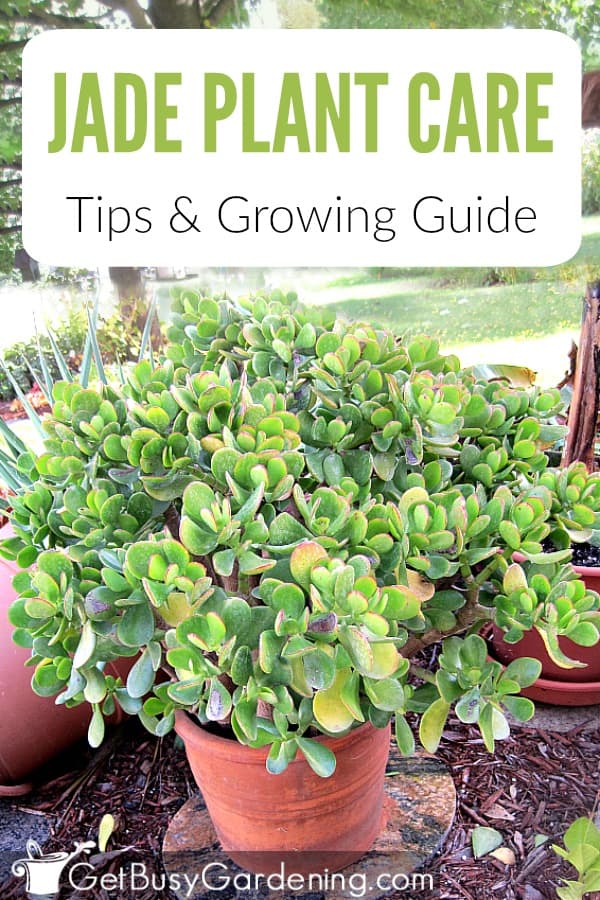
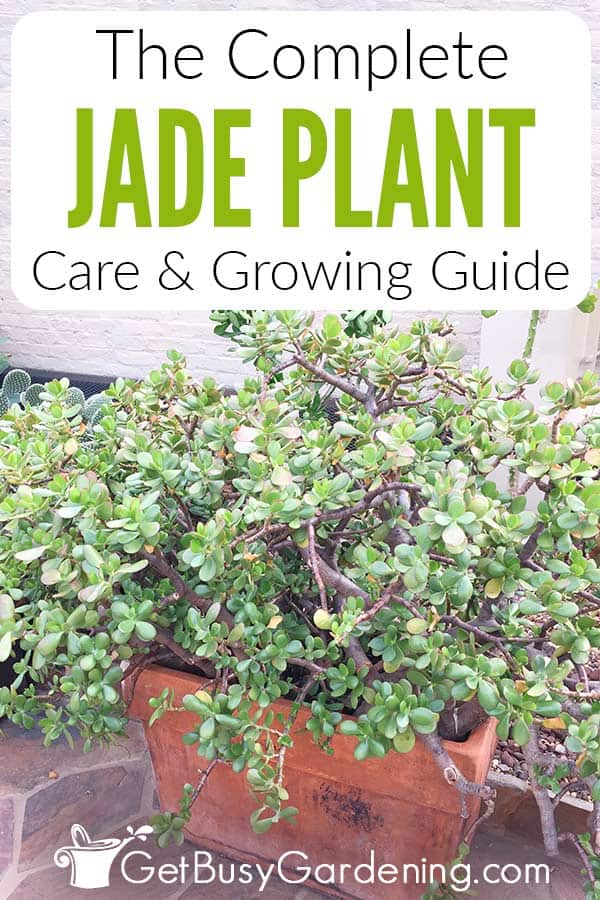
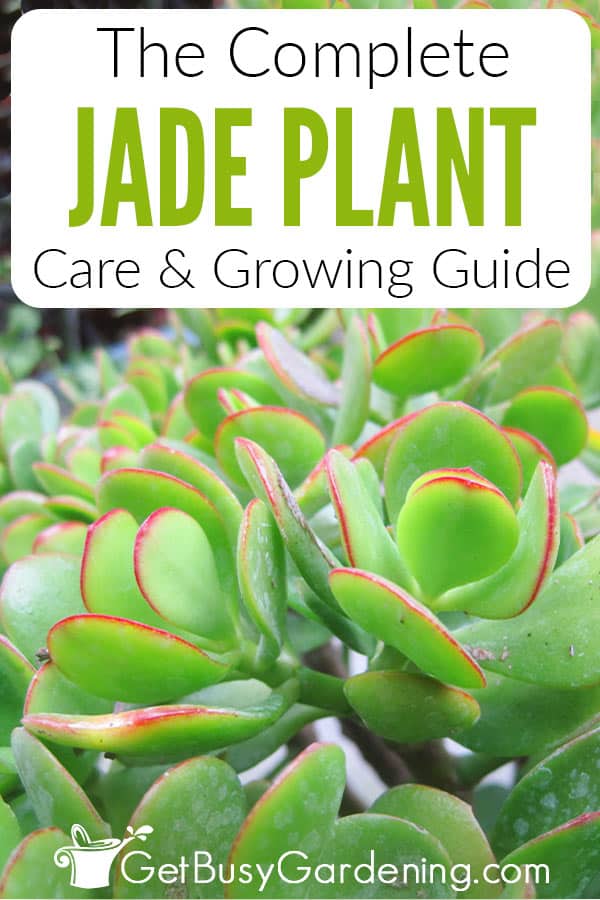
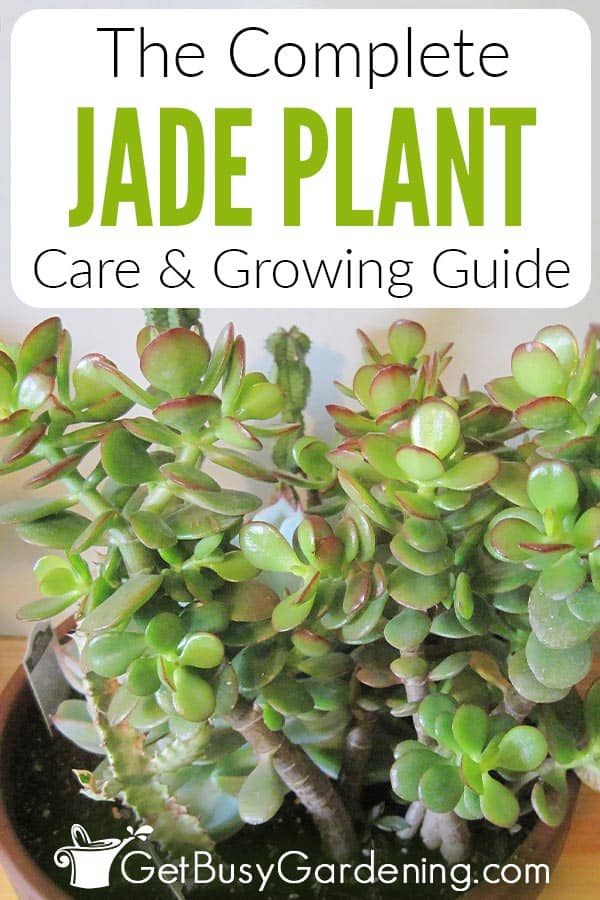
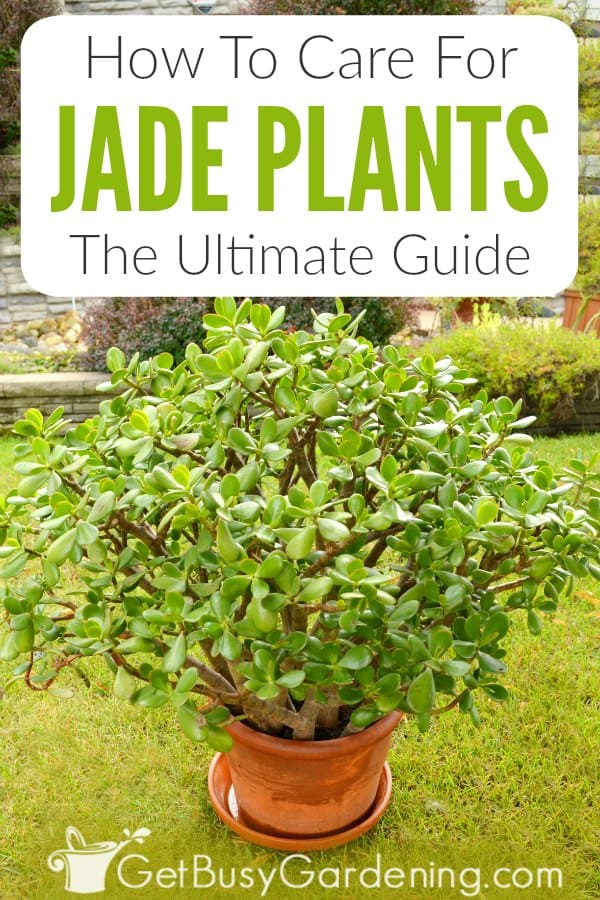
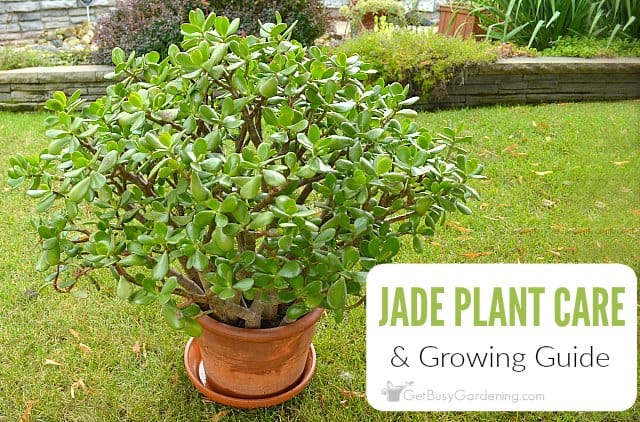




Cynthia says
Hi, wondering if I can start new plants with those prices that have aerial roots?
Amy Andrychowicz says
Yes, you can start new jade plants with the pieces that have aerial roots. In fact it will give you a nice head start! Simply follow the steps above to take and cure the cuttings, then just plant them in soil so all the aerial roots are covered.
Denise Kowalczyk says
Hi Amy!
I am so glad I found your site. I am your height across the border. I have several jades. They don’t get very big. The problem I have run into is white spots developing on one or 2 Plants once in awhile. I can rub them off but would like to know what causes that to happen. It mostly happens to the ones that are in front of my south facing patio doos.
Thank you!
Amy Andrychowicz says
Uh oh, it sounds like your jades could have mealybugs. Take a close look at the white spots to make sure. Here’s more info to help you ID them, and get rid of them, if that’s the problem… How To Get Rid Of Mealybugs, For Good!.
Tanya says
I’ve recently sprayed my Jade plant with white oil and used worn wee to fertilise. The leaves are falling off in the dozens. Have i done something wrong here and is there any cure to stop the leaf fall? Help please?
Thank you.
Amy Andrychowicz says
Oh no, sorry to hear your jade is dropping its leaves! When that happens, it’s usually due to improper watering – most commonly overwatering. Check the soil by sticking your finger down at least one inch. It should feel completely dry before you water it again. Also, check the base of the main stem to make sure it’s not mushy. If it is, then you should take and root the cuttings to try to save your plant. Good luck!
Julie Nichols says
I have some cuttings in small (3-4 inch) pots that have rooted and are about 3-5 inches tall. When do I repot them in a bigger pot, what size pot should I go up to and how long should I wait to prune them to promote bushy growth?
Amy Andrychowicz says
Jade plants can usually stay in the same pot for a long time, and it’s best not to put them into one that is too large. You can wait until you see the roots growing out of the bottom of the container, or when it becomes pot-bound. Only go one size up. So for yours, choose a 5-6″ pot. Make sure it has drainage holes in the bottom, and use a fast-draining soil mix.
Emily Scarbrough says
Hi, I’ve recently acquired a large jade plant but have found multiple branches shriveled. I am very concerned and trying to save it, and was hoping you’d have some advice? So far I have removed all the soil from its roots, and let it sit for 48 hours to let it dry out completely. The roots were dry and firm but some wrinkled and dead, so I removed those as best I could. I’m now trying to prune any branches that appear to be rotting or could be a problem to the longevity of the plant. Many of them have brown in the cross section of the stem when I cut them off though, and I don’t want to cut too many to cause more issues. Do you have any advice as to how to know when a branch must be pruned and when it should be left to recover? Thanks so much 🙂
Amy Andrychowicz says
Oh no, sorry to hear your jade plant is struggling. When the leaves shrivel, it could be either from under watering, or the stem may be rotting from previous overwatering. Check the base of the main stem to make sure it’s not soft of mushy. If the stem and branches are fairly firm, and not super soft, then it may just be that the plant was neglected and needs a good drink of water. On the other hand, if any part of the stem is rotted, then you may need to take cuttings and root those to save it. I would not prune it anymore until you figure out what the problem is. If the stem and branches are fairly firm, then I would pot it back up, give it a good drink of water (allowing the excess to drain completely from the pot) and leave it alone. If it was just a lack of water, it should start to plump back up in a few weeks.
Emily Scarbrough says
Amy,
Thanks so much for your feedback. Unfortunately once we cut into the base of the stems, we found rot throughout the plant. We’ve taken as many healthy cuttings as we could, dipped them in root powder, and have left them to dry out before planting them into well-draining soil (mixed with 50% perlite). It was heartbreaking to have to cut apart such a large, beautiful plant, but we had to try to save it. Hopefully these cuttings will flourish. Do you have any tips about propagating jades? We are completely new to this and don’t want to kill this already delicate little guy.
Amy Andrychowicz says
Oh no, I am so sorry to hear your jade was rotted throughout, that is so heartbreaking. Glad to hear you were able to take healthy cuttings. Here’s a detailed post about successfully propagating them… How To Propagate Jade Plant Cuttings. Good luck!
Emily says
Thank you for your response — unfortunately my jade had a very rotted stem, thus I ended up having to take cuttings and propagating them. While it was such a shame to lose such a large, beautiful floor plant, I was able to successfully save most of the cuttings. They have taken well and seem to be healthy, which I am very pleased with given the state of the original plant.
Thanks again for your advice — it was very helpful. 🙂
Amy Andrychowicz says
Such a bummer you lost your original jade plant to rot. But I’m super excited to hear you were able to save several cuttings, that’s great news! You’re welcome, always happy to help.
JC says
Hi I got a gorgeous Jade plants outdoor. It used to be bushy with very thick roots. This year it didn’t flower at all and lately I noticed that it is sort of spreading/splitting in the middle leaving bigger and bigger gap in the centre of the plant.
Can you please help by telling what is happening? I’ve got many different plants from this big one that I have repotted. It has been great considering I got it approx 10cm from a friend several years ago
Amy Andrychowicz says
If the middle of the stem/trunk is cracking and splitting, then your jade could either be getting too heavy, or it could be rotting. Check the entire stem, especially the part that is splitting open to make sure it’s not mushy or soft. If it’s healthy, then the best thing to do is prune back the heavy branches that are causing it to split.
Marie Price says
I started a jade plant from two leaves 10 year ago. Today it is two thick brownish stems with a few leafy sprouts. Every time it gets new branches they ultimately fall off. Now one of the stems has simply drooped to the point of a literally growing upside down! Not sure if I should prune off the branch or just let it hang there. HELP. Each stem was at least a foot high with only a couple of branches, each branch only a few inches. It’s not an attractive plant but considering how it started and how old it is… I don’t want to dispose of it. I’m a pretty accomplished gardener but apparently NOT WITH THIS SUCCULENT
Amy Andrychowicz says
When jade plant stems fall off the like that, it’s almost always caused by overwatering. Stick your finger at least one inch into the soil. It should feel completely dry before you water it again. Also, make sure it’s in a pot that has drainage holes. Yes, you can prune off the ugly or dying growth, no problem.
Marri says
I braved it and split my jade plant I bought 3 years ago. It was three separate plants, with 3 or 4 woody trunks. I had been doing light prunes over the years, but decided to shape the trees several weeks after repotting. There was one I was really looking forward to bringing on as I loved the overall arrangement of the trunks. Yeah it has other plans, obviously. Wherever I pruned it has NOT grown new leaves. It’s as if it is dormant, but I know it’s not because other areas are growing. The other plants are doing beautifully – albeit they make their own minds up in how many new leaves and in what direction they will grow.
Is there anything I can do to encourage it to grow? I hate to keep cutting down another set of leaves or two because I think I am going to end up with a stump.
Amy Andrychowicz says
It can take some time for jades to start filling in again after pruning them, so sometimes it’s just patience. But, since you mentioned the others are already growing back, check the stems that you cut on the slow one to make sure they aren’t rotting. If moisture got into the cut, it can cause tip rot, which would explain why they aren’t getting new leaves. If the stems on your slow-growing jade are rotting, the you’ll definitely want to cut off all of the rot. Then make your final cut at a downward angle to prevent water from pooling in the wound. Good luck!
Marri says
Thanks for replying Amy. The areas that were pruned are healthy. They have calloused over and I have no overall worries over the plant. Guess I will just have to be patient.
Amy Andrychowicz says
You’re welcome! Glad to hear they aren’t rotting. Hope you’ll start to see new growth soon. 🙂
Lanie says
Can you talk a bit about reporting jades and how often thanks
Amy Andrychowicz says
Yes! Jade plants have very shallow roots. So, they can live in the same container for many years without being repotted. In fact, it’s better to keep them a bit root-bound, rather than put them into a pot that’s too large. Signs that it needs to be repotted are that the plant is top-heavy and keeps falling over, roots are growing out of the drainage holes, the pot looks as if it’s about to bust open, or your jade has stopped growing after many years of being in the same pot.
Michele says
When I do water it, how much water should I put in the soil ?
Amy Andrychowicz says
Water your jade plant when the soil is completely dry. Check it by sticking your finger at least one inch into the soil. If it feels wet at all, wait to water it. When you do water, give it a deep drink. I like to pour it over the soil until it starts flowing out the bottom of the pot, then I stop. If it’s sitting in a drip tray, then make sure you empty it right away, and never leave your jade soaking in it.
Jan Scribner says
My jade is outdoors in Sw Florida I never water what about in summer when it rains every day should I move it where it won’t get wet but then no sun?
Amy Andrychowicz says
In your rainy climate, I would definitely make sure your jade is potted in an unsealed clay or terracotta pot, using a sandy, porous, fast draining soil (a gritty soil mix is great for this). That will help it dry out much faster after all the rain. If you can put it in a protected spot during the rainy season, that would help. You definitely don’t want to put it somewhere that gets zero sunlight. But a partial shade spot will be ok for a few weeks, especially during the winter months.
Elizabeth says
I inherited a large Jade house plant. The main stem is 12 in tall by 2 on wide. It is woody. There three other large stems growing from base of main. We have had it for a year. We did have it in north facing area but it had not been doing welll. So we moved it to a southern window. It is dropping leaves but worse yet the woody branches are dropping. I can not figure out what is causing the dropping. It does not seem short on water. I may have been under watering it but when we watered more it seemed too moist. Any ideas? I will be so appreciative of the advice! Thank you! Elizabeth
Amy Andrychowicz says
Sorry to hear that your jade plant is not doing well. You did the right thing by moving it to a sunny window, they need LOTS of light indoors, so a south facing window is ideal. When the leaves and stems start to drop off, that is almost always caused by overwatering. The soil should dry out completely between waterings, especially during the winter months. Under watering is hardly ever a problem, especially for large jades. Stick your finger at least one inch into the soil to check the moisture level. If it’s damp at all, then don’t water it until it feels completely dry. I water my large jade (it’s 3′ tall, 2′ wide, and in a 14″ pot) maybe 3-5 times during the entire winter, just to give you an idea of how much they need.
Susan Cuddihy says
Hi my jade plant is over 45 years old and gigantic also very heavy , just now ( December) its broken out in lots of flowers , my 1st time for it to blomme in the 5 years I’ve had it , is this because I’ve fed it ?
Amy Andrychowicz says
How fun! I love when my jade plant blooms, it’s such a treat! The flowers are trigger by cooler fall temperatures, so you must have had the perfect weather for it this fall. I explain more above in the section titled “Jade Plant Flowers”.
Julie Patterson says
I am new to house plants. A neighbor gave me an older jade plant. It seems healthy. The branches have gotten to the point they have made a “U” and started to grow up. Do I cut them down?
Amy Andrychowicz says
Yes, you can prune your jade plant for size and shape. See the “Jade Plant Pruning Tips” section above for details.
Therese Marsh says
my “just cut back and repotted” Jade is growing fast a d furious roots on the branches. Is there anything I did wrong, or need to make it right??
Amy Andrychowicz says
Those roots growing from the branches of your jade plant are called “aerial roots”. They won’t harm your plant, but can be a sign of other problems – mainly improper watering. Jade plants will grow roots from their stems or branches when they aren’t getting enough water, especially in humid environments. They absorb water through their roots, so the aerial roots allow them to get moisture through the air when they aren’t getting enough via the soil. So, the easy answer is that you need to give your jade deeper waterings, and possibly more often. BUT, air roots could also be a sign of stem rot. First thing to do is check the base of the stem to make sure it’s firm, not soft or mushy. If that’s all good, then check the type of soil you used. If you used the wrong soil when you repotted it, that may be the problem. Jade plants need a porous soil so they can absorb plenty of water, but won’t be in danger of being overwatered. If you used regular potting soil, then I would switch it out with a porous mix (like my DIY succulent soil, for example). See the “Best Potting Soil For Jade Plants” section above for more details.
Gissela Casco says
I recently received a jade plant as gift from my mom. I repotted it with mixed soil and gritty mix. The plant was doing fine and looked beautiful. A few weeks later I noticed white spots on some leaves that looked like mold so I clipped off the leaves. Then I noticed that a couple of stems were growing mold. I researched to just wipe it off but noticed that it would leave a black stain. I also read the cause can be poor air circulation and not enough sunlight. I live in a NYC apt, I get some sunlight during afternoon hours in my bedroom where I kept the plant. I then started to move it out to my yard for more sunlight in the morning. The plant was developing more mold. I thought maybe it was the roots and I removed it from the soil and it was fine, so I repotted it back. At this point I am not sure what else to do and cannot find much info on this pesky mold. I’m definitely going to get a grow light to see if this would help especially during the winter months. Any suggestions or tips would be greatly greatly appreciated to help me save this beautiful plant.
Thank you,
Gissela
Amy Andrychowicz says
Uh oh, I don’t think your jade plant has mold… it sounds like a mealybug infestation to me. Here’s detailed information about how to treat your plant… How To Get Rid Of Mealybugs On Houseplants. Good luck!